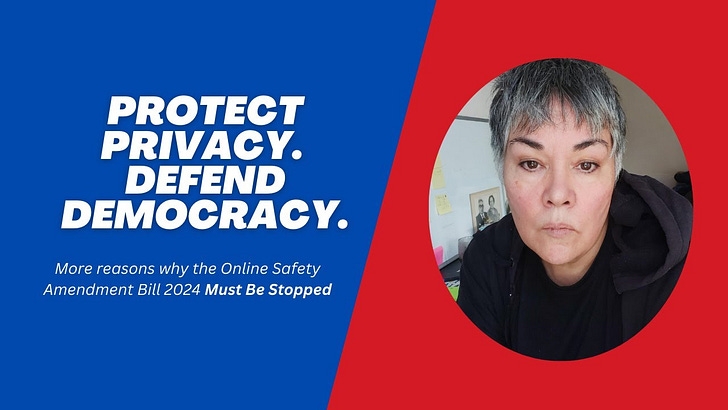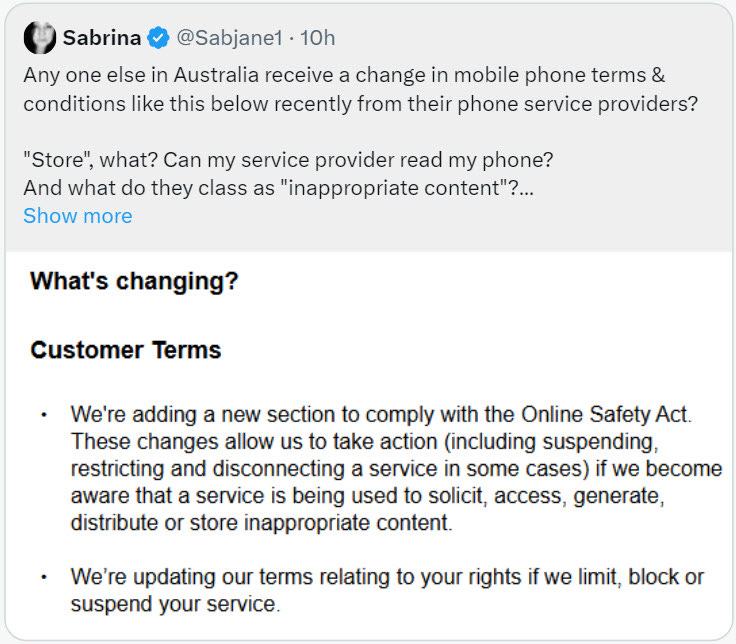Breaking Down the Online Safety Amendment (Social Media Minimum Age) Bill 2024
This is a specific breakdown of the bill for lawmakers and proof for the general public
(This is based on Sam Connor’s Analysis see Link dated November 21/2024 @criprights this post is structured to assist letter writing for the senate/MPs)
The Online Safety Amendment (Social Media Minimum Age) Bill 2024 contains provisions that go far beyond protecting children online. Upon closer examination, the bill reveals a disturbing framework for surveillance and digital control. Here's a breakdown of its most concerning aspects and their potential impacts
1. Surveillance Infrastructure Creation
Key Sections: 63D and 63F*
Age Verification Requirements: Platforms are mandated to "take reasonable steps" to verify users' ages, necessitating the collection and storage of identity verification data.
Data Sharing with Third Parties: The bill permits sharing of this data with third-party verification services, leading to the creation of databases that link real identities to online accounts.
Privacy Concerns in Section 63F: While ostensibly protecting privacy, this section allows data sharing with user "consent," which can be embedded in terms of service agreements. It also facilitates the creation of centralized identity verification databases, has weak data deletion requirements, and permits government access to verification data.
2. Broad Data Collection Framework
Key Section: 63C*
Defines "age-restricted social media platforms" broadly, capturing any service with a "significant purpose" of social interaction.
Grants the Minister power to expand definitions through legislative rules.
Platforms must track user locations in Australia and collect identity documents.
Section 63C(1)(a)(iv) allows the Minister to impose "such other conditions" via legislative rules, expanding data collection requirements without new legislation.
Why this matters: Such provisions are ripe for misuse. Similar legislative processes, like those under the NDIS Rules, have already been manipulated to expand power unchecked.
3. Alarming Control Mechanisms
Key Section: 63E*
Ministerial Powers: The Minister can specify implementation dates, modify requirements through legislative rules, and expand the scope of platforms covered.
Limited Parliamentary Oversight: Sections 27(1)(qa) and 27(1)(qb) grant the Commissioner broad powers to create guidelines for verification, modify requirements, enforce compliance, and issue penalties.
4. Expansion Potential
Section 63C allows the Minister to specify additional services through legislative rules without limits.
The verification framework could be extended to other age groups—adults included.
Platforms face penalties of up to $49.5 million, coercing them to:
Implement intrusive verification systems.
Track user behavior.
Build content monitoring systems.
Store identity documents.
Share data with authorities.
Future Implications: These systems create an infrastructure for identity verification, user tracking, and behavioral analysis, with minimal privacy protections.
5. Real-World Impact
This bill establishes mechanisms that could be expanded to control populations under the guise of child safety. Potential outcomes include:
Political monitoring: Tying online identities to real-world activities.
Behavior tracking: Profiling users through age verification systems.
Movement control: Using location tracking.
Information restriction: Controlling access to platforms.
Population surveillance: Centralized databases for monitoring citizens.
i.e. Privacy Risks: Section 63F's "privacy protections" enable data retention, identity linking, profile correlation, behavior tracking, and government access.
i.e. Commercial Surveillance: Section 63C(3) ensures that advertising and revenue generation are not exempted, suggesting potential for commercial surveillance.
6. Privacy Risks in Disguise
Section 63F's "privacy protections" enable:
Data retention and identity linking.
Profile correlation and behavior tracking.
Government access to sensitive data.
Section 63C(3) ensures advertising and revenue generation are not exempted, paving the way for commercial surveillance.
Sam's Warning: "This is not just about protecting children. This bill represents one of the most dangerous and far-reaching attempts at digital control ever proposed in a democratic nation."
Call to Action
This bill isn't just a legislative overreach—it’s a threat to democracy, privacy, and free expression. Its vague requirements, combined with severe penalties, will force platforms to adopt the most intrusive surveillance methods possible. Australians must push back against this alarming erosion of our rights.”
By Sam Connor
For a comprehensive understanding, readers are encouraged to review the full legislative text: Online Safety Amendment (Social Media Minimum Age) Bill 2024.
Note: The links provided direct to the specific sections of the bill for verification and further reading.
*
Online Safety Amendment (Social Media Minimum Age) Bill 2024 along with their corresponding page numbers in the official PDF document:
Section 63C: Definition of "age-restricted social media platform"
Page 4 of the PDF
Section 63D: Obligations of providers of age-restricted social media platforms
Page 5 of the PDF
Section 63E: Minister's power to determine requirements
Page 5 of the PDF
Section 63F: Privacy protections
Page 6 of the PDF
Sections 27(1)(qa) and 27(1)(qb): Commissioner's powers regarding guidelines and enforcement
Page 3 of the PDF
You can access the full text of the bill here: Online Safety Amendment (Social Media Minimum Age) Bill 2024.
To locate each section:
Open the PDF document.
Use the page numbers provided above to navigate to the specific sections.
Note - Check your Mobile Phone’s Update on Terms of Service, is the Government rolling this out even without it being passed (after 1 day consultation) in parliament?




